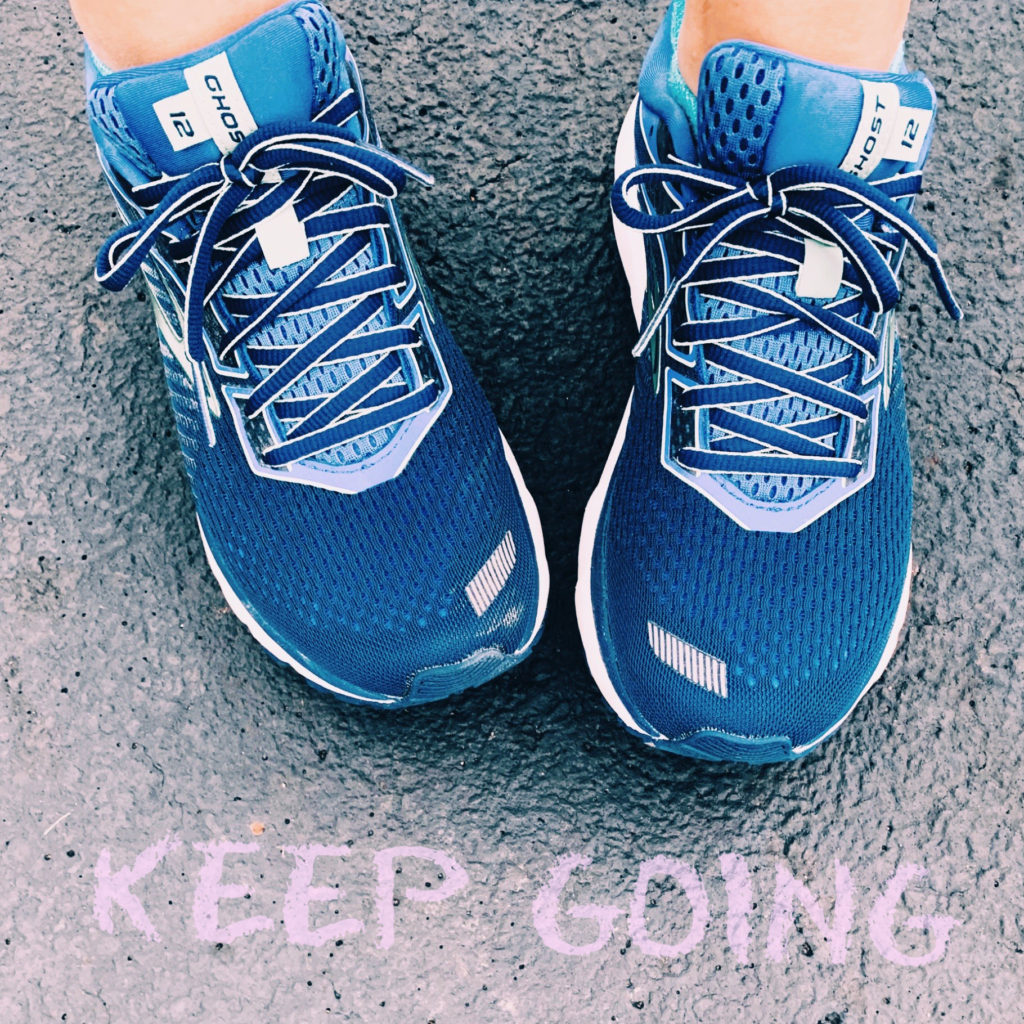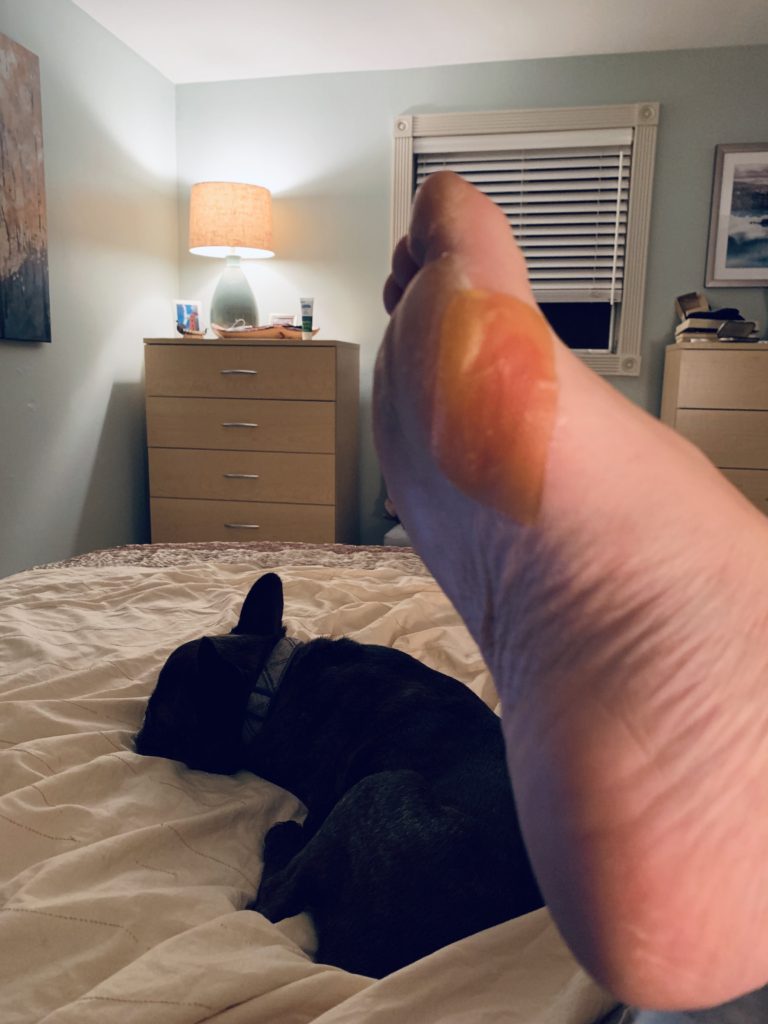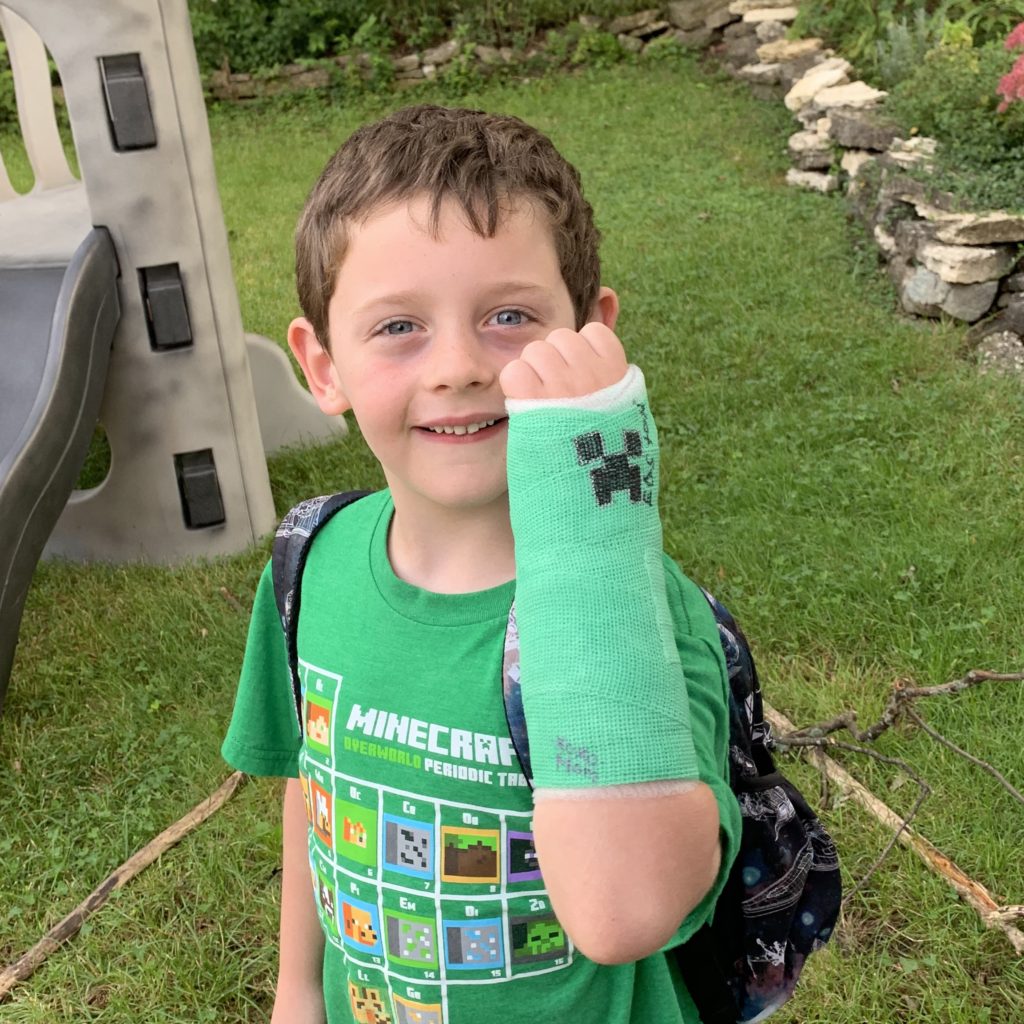Last week was the week of marathon training where everything goes wrong or everything goes right: The week that culminates in the 20-mile long run, which is the longest distance you’ll run during training for the race.
For me, it didn’t start on a high note. My Monday 5-mile run ended with me limping and upon inspection of my feet, the formation of a giant blister on the arch of my foot. This isn’t normal, and it was the tipping point to realizing that the new shoes I got a month ago are NOT the shoes for me.
I got my shoe problem squared away that night but the blister problem loomed: By Tuesday, it wasn’t a blister any more. It was more like a full-on friction burn that was painful to walk on. I soaked my feet in Epsom salts, bandaged it up, and took two days off of training.
On Thursday, I was feeling antsy about getting my miles in and hitting the target for the peak week of training. I already knew the full 40 miles for the week was unrealistic, but I decided to get in a quick 5 miles again. By the end of the fifth mile, I felt the twinge on my arch again, but pushed it out of my head.
Saturday was the day. The 20-miler. I had a group to run with. I had a marathon outfit to pilot. The weather was favorable. I bandaged and taped the hell out of my blister on advice from other runners, and I got out there.

Within two miles, I knew that everything was off. My body didn’t feel good. I blamed it on the humidity and persevered. But by the time I reached the water stop at 6.5 miles in, I knew something was wrong. Really wrong. I told my group to go ahead without me and I took off my shoe and sock to a bleeding, swollen, red-hot mess. No wonder it hurt to take a single step, much less run.
I swallowed all of my pride and called my husband to pick me up. 20-miler — aborted. I didn’t want to quit … but I also knew that if I didn’t stop, I’d be killing my marathon dream before I even made it to the starting line.
Moving forward after a fail isn’t easy. It doesn’t have to be a fitness goal that hits a snag: It can be starting a business, or getting out of debt, or writing a novel, or receiving a health diagnosis you don’t want to hear. But whatever the goal and whatever the hang-up, there are ways to keep going. Here’s the step-by-step guide to moving forward:
How to Survive a Setback
1. Cry it out.
As soon as I hung up with #DoneWithFun Daddy after giving him the address of where I was stranded, the tears started to flow. I felt defeated. Embarrassed. Frustrated.
Don’t insist on holding back the tears. Crying is cathartic. It releases some of those big emotions and frees space in your mind for the next step.
2. Give yourself time to process.
My head was going a mile a minute, racing from negative thought to negative thought. I needed to reset. I took a long hot shower and followed it with hot coffee, solo. Even a simple act of self-care give you permission to slow down and start to make sense of what happened.
Wallow a bit if you need to. I’m not embarrassed to admit I felt sorry for myself all day. I sat in bed, my foot throbbing, and gave in to the pity party. The secret about pity parties is this: They’re about as fun as a child’s birthday at Chuck E. Cheese. After an hour or two, you’re over it.
3. Let go of what you can’t control.
I react to adversity by trying to lock it down and control every single factor that I possibly can. If I can control the present, I can control the future. Right?
WRONG. I can’t control how long my healing will take, and I can’t predict what will happen when I run again. I also can’t change the past by beating myself up for my (admittedly poor) decision to push myself and attempt the 20-mile run. In hindsight, I know my motivation for doing it was wrong — but knowing that doesn’t change the present. So I’m channeling my inner Elsa, as I do so frequently, and Letting. It. Go.
4. Ask for help.
You’ve cried, you’ve wallowed, you’ve let some shit go. Now is the time to become proactive. Seek advice from an expert and welcome the support from your loved ones. You don’t have to handle a setback by yourself. Listen to the people around you when they give you a pep talk, and let their unflagging support rebuild your shaken confidence.
I did some research online about blister care and the impact of not running during the “taper” period of marathon training (i.e., the last weeks before the race). The texts and comments and DMs I received from all of you with encouragement, ideas and advice are the thing that made the difference. One friend brought me wound care supplies from her healthcare job (freaking miraculous). Another talked me through ideas for maintaining cardio fitness without destroying my feet as they healed (such a smart idea). Knowing that I wasn’t alone is what gave me the strength to move on to the next phase.

5. Make a plan.
A realistic plan. A day-by-day, or week-by-week, list of what can and can’t be done. Writing it down is optional but encouraged; seeing it in black and white makes it easier to commit to.
My plan? Rest. Stay off my foot. Keep the injury from getting infected and allow it to heal. That means no running, period. For at least 5 days but more likely a full week.
6. Stick with the plan.
Now the hard part: Sticking with it. As the trauma starts to heal (physically or emotionally), it’s easy to tell yourself that your plan was unnecessarily long, complicated or overdone. It’s easy to want to return to the status quo as soon as possible. Fight the urge to rush it.
It’s Tuesday night, and I haven’t run for 3 days. The weather is perfect running weather and I’m itching to get back out there. I want to know what will happen if I run on the partially healed wound. But I’m keeping myself benched until Friday at a minimum.

7. Take it day by day.
The best advice I received this weekend came from my husband, as I was despairing about all of my marathon bucket list dreams coming to a crashing halt because of a stupid blister. (Cue the dramatic overture music.) He told me not to get ahead of myself and to take it day by day.
Simple, right? Stay present and in the moment instead of getting caught up in the tailspin of “what if” anxiety. One day at a time is how goals get accomplished, and one day at a time is how recovery happens. There’s a reason this is an AA aphorism.
8. Trust your intuition.
I don’t know now if the marathon on October 12 is meant to be. I’m not making that decision yet. But I’ll tell you what I do know: I’ll listen to my body and trust my intuition when making the final decision to run or not to run. I will not run the race if I know in my heart it’s going to end in injury. I’ve said that from the beginning. Having a big audacious goal is a great thing, but hurting yourself to reach it is not.
Trust the timing too. I believe that everything happens for a reason. If now isn’t the right time for you to reach your goal, a month from now may be. Or a year. Or a decade. Don’t write it off just because now isn’t the right time.
9. Dust yourself off and try again.
If there’s any step in this process that you don’t skip, it’s this one. I teach my kids to get back up when they fall, brush themselves off, and keep going. If they can do it, so can I — and so can you. It’s scary to put yourself out there again and risk failure, or injury, or consequences. But you’ve only failed when you quit trying.
I’m already feeling anxious about running again. Will I reopen the wound all over again and be back at square one? And if so, what does that mean for the marathon? But the fact is, I won’t know until I try. And try I will.
10. Repeat as necessary.
Setbacks aren’t limited to one. You might try again and end up in exactly the same place. You might try again and make forward progress but still not hit the target. Setbacks can pile upon setbacks (trust me — we went from my running blister crisis to Easton’s broken arm in an alarmingly short time).

But just as there will always be setbacks, there will always be the opportunity to start again. Start over, cry it out, and keep moving forward. That’s what I do.
I don’t know how this ends for me just yet. The marathon is less than three weeks away, so I’m still hanging out at Steps 6 and 7 — taking it day by day and sticking with the plan to R-E-S-T and see what happens. A test run this weekend will be telling — but I’m not thinking about that just yet. I’m diligently soaking my foot in Epsom salts and applying my medical-grade honey dressing, and I’ll deal with the weekend when it’s upon us.
What do you do in the face of adversity? What motivation or mantra helps you? Inspire me in the comments below or share your favorites on social media with #neverdonewithfun.
Keep following on Instagram and Facebook for updates on how this turns out. Marathon or no marathon, I can tell you this: I’ll keep going.














